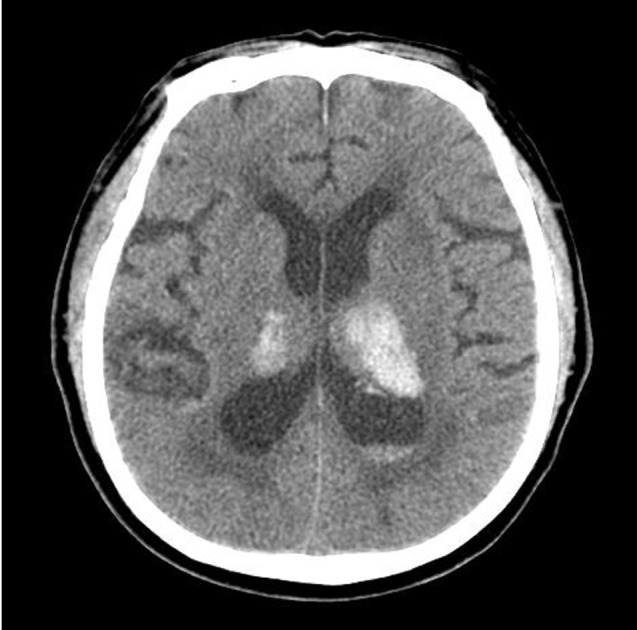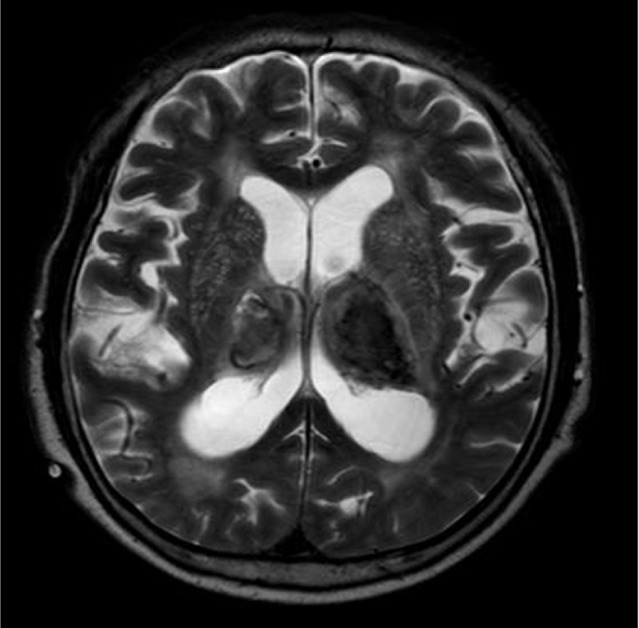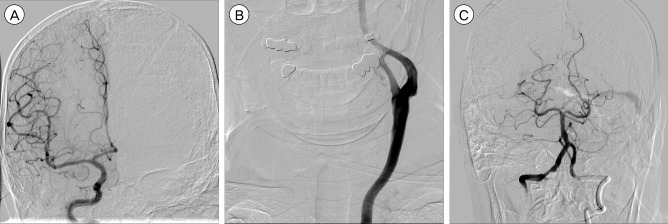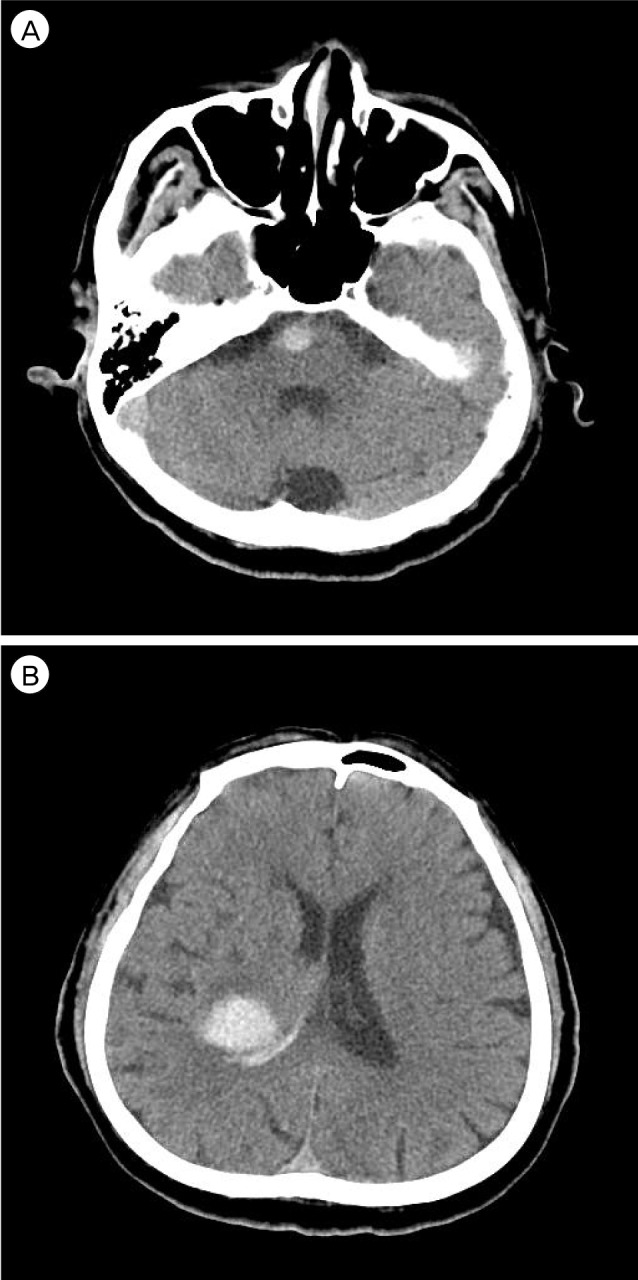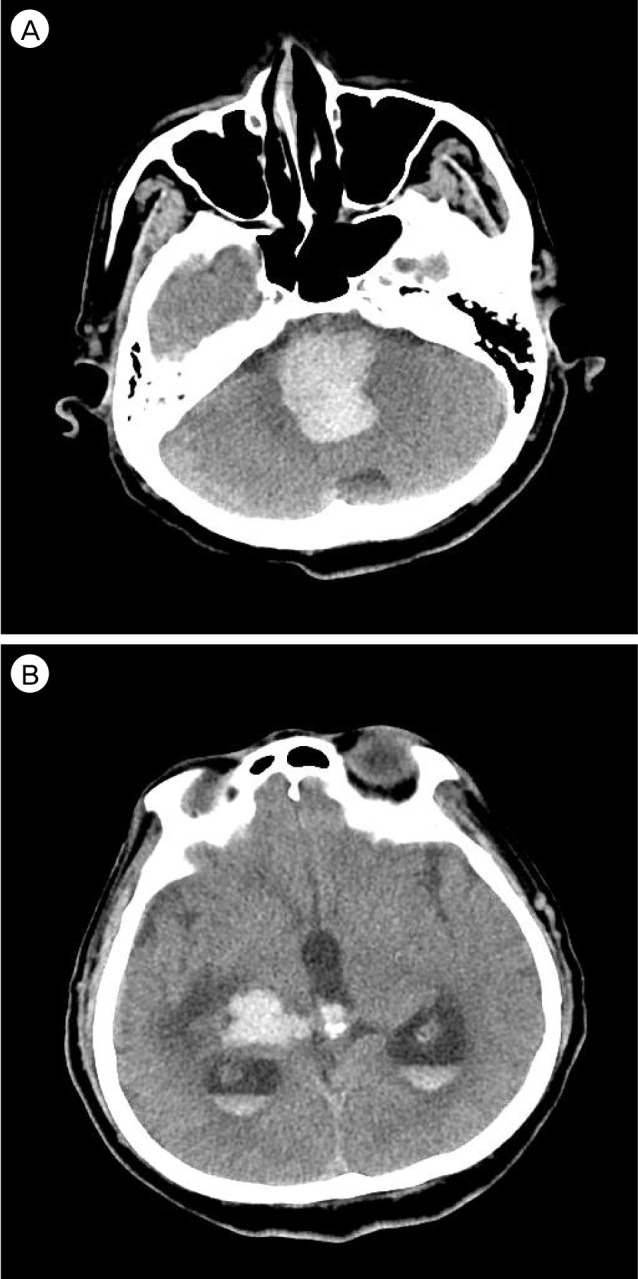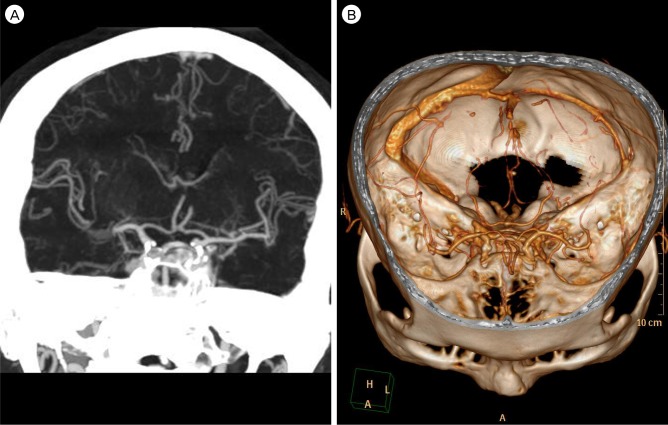J Cerebrovasc Endovasc Neurosurg.
2014 Jun;16(2):104-111. 10.7461/jcen.2014.16.2.104.
Multiple Spontaneous Simultaneous Intracerebral Hemorrhages
- Affiliations
-
- 1Department of Neurosurgery, Chung-Ang University College of Medicine, Seoul, Korea. cuttage@cau.ac.kr
- KMID: 1963178
- DOI: http://doi.org/10.7461/jcen.2014.16.2.104
Abstract
- Simultaneous occurrence of intracerebral hemorrhage (ICH) in different arterial territories is an uncommon event. We report on two cases of multiple spontaneous simultaneous ICH for which we could find no specific cause. A 73-year-old man, with no related medical history, was admitted to the hospital with simultaneous bithalamic ICH, and subsequently died of recurrent pneumonia. Second patient was a 60-year-old man who presented with simultaneous ICH in the pons and thalamus; he died of recurrent bleeding. We review the possible pathological mechanisms, clinical and radiologic features of simultaneous multiple ICH.
Keyword
Figure
Cited by 1 articles
-
Multiple Spontaneous Intracerebral Hematoma without Presenting Risk Factors
Sangman Park, Eun-Kyung Park, Ju-Seong Kim, Kyu-Won Shim
J Cerebrovasc Endovasc Neurosurg. 2016;18(3):286-290. doi: 10.7461/jcen.2016.18.3.286.
Reference
-
1. Amin OS, Rasheed AH, Ahmed SM. Simultaneous intracerebral haemorrhages; which came first, the supra-tentoral or the infra-tentorial one? BMJ Case Rep. 2010; 8. 19. 2010.
Article2. Bamford J, Sandercock P, Dennis M, Burn J, Warlow C. A prospective study of acute cerebrovascular disease in the community: the Oxfordshire Community Stroke Project-1981-86. 2. Incidence, case fatality rates and overall outcome at one year of cerebral infarction, primary intracerebral and subarachnoid haemorrhage. J Neurol Neurosurg Psychiatry. 1990; 1. 53(1):16–22. PMID: 2303826.
Article3. Biffi A, Greenberg SM. Cerebral amyloid angiopathy: a systematic review. J Clin Neurol. 2011; 3. 7(1):1–9. PMID: 21519520.
Article4. Chanda A, Nanda A. Multiple cavernomas of brain presenting with simultaneous hemorrhage in two lesions: a case report. Surg Neurol. 2002; 5. 57(5):340–344. discussion 344-5. PMID: 12128311.
Article5. Choi JW, Lee JK, Kim JH, Kim SH. Bilateral simultaneous hypertensive intracerebral hemorrhages in both thalami. J Korean Neurosurg Soc. 2005; 12. 38(6):468–470.6. Imai K. Bilateral simultaneous thalamic hemorrhages-case Report. Neurol Med Chir (Tokyo). 2000; 7. 40(7):369–371. PMID: 10927905.7. Kabuto M, Kubota T, Kobayashi H, Nakagawa T, Arai Y, Kitai R. Simultaneous bilateral hypertensive intracerebral hemorrhages-two case reports. Neurol Med Chir (Tokyo). 1995; 8. 35(8):584–586. PMID: 7566389.8. Kase CS, Pessin MS, Zivin JA, del Zoppo GJ, Furlan AJ, Buckley JW, et al. Intracranial hemorrhage after coronary thrombolysis with tissue plasminogen activator. Am J Med. 1992; 4. 92(4):384–390. PMID: 1558085.
Article9. Kohshi K, Abe H, Tsuru E. Simultaneous hypertensive intracerebral hematomas: two case reports. J Neurol Sci. 2000; 12. 181(1-2):137–139. PMID: 11099724.
Article10. Komiyama M, Yasui T, Tamura K, Nagata Y, Fu Y, Yagura H. Simultaneous bleeding from multiple lenticulostriate arteries in hypertensive intracerebral haemorrhage. Neuroradiology. 1995; 2. 37(2):129–130. PMID: 7760998.
Article11. Mühlau M, Schlegel J, Von Einsiedel HG, Conrad B, Sander D. Multiple progressive intracerebral hemorrhages due to an angiosarcoma: a case report. Eur J Neurol. 2003; 11. 10(6):741–742. PMID: 14641524.
Article12. Mauriño J, Saposnik G, Lepera S, Rey RC, Sica RE. Multiple simultaneous intracerebral hemorrhages: clinical features and outcome. Arch Neurol. 2001; 4. 58(4):629–632. PMID: 11295994.13. Ooneda G, Yoshida Y, Suzuki K, Sekiguchi T. Morphogenesis of plasmatic arterionecrosis as the cause of hypertensive intracerebral hemorrhage. Virchows Arch A Pathol Pathol Anat. 1973; 10. 361(1):31–38. PMID: 4202241.
Article14. Sato M, Tanaka S, Kohama A, Sone T, Fukunaga M, Morita R. Spontaneous bilateral intracerebral hemorrhage occurring simultaneously-case report. Neurol Med Chir (Tokyo). 1986; 7. 26(7):545–547. PMID: 2430218.15. Seijo M, Ucles A, Gil-Nagel A, Balseiro J, Calandre L. Multiple cerebral hematomas: review of 7 cases. Rev Neurol. 1996; 5. 24(129):549–553. Spanish. PMID: 8681171.16. Sorimachi T, Ito Y, Morita K, Fujii Y. Microbleeds on gradient-echo T2(*)-weighted MR images from patients with multiple simultaneous intracerebral haemorrhages. Acta Neurochir (Wien). 2007; 2. 149(2):171–176. discussion 176-7. PMID: 17211554.
Article17. Stemer A, Ouyang B, Lee VH, Prabhakaran S. Prevalence and risk factors for multiple simultaneous intracerebral hemorrhages. Cerebrovasc Dis. 2010; 8. 30(3):302–307. PMID: 20664265.
Article18. Sunada I, Nakabayashi H, Matsusaka Y, Nishimura K, Yamamoto S. Simultaneous bilateral thalamic hemorrhage: case report. Radiat Med. 1999; Sep-Oct. 17(5):359–361. PMID: 10593286.19. Tanno H, Ono J, Suda S, Karasudani H, Yamakami I, Isobe K, et al. [Simultaneous, multiple hypertensive intracerebral hematomas: report of 5 cases and review of literature]. No shinkei Geka. 1989; 3. 17(3):223–228. Japanese. PMID: 2671770.20. van Asch CJ, Luitse MJ, Rinkel GJ, van der Tweel I, Algra A, Klijn CJ. Incidence, case fatality, and functional outcome of intracerebral haemorrhage over time, according to age, sex, and ethnic origin: a systematic review and meta-analysis. Lancet Neurol. 2010; 2. 9(2):167–176. PMID: 20056489.
Article
- Full Text Links
- Actions
-
Cited
- CITED
-
- Close
- Share
- Similar articles
-
- Stereotatic Aspiration of Simultaneous Bilateral Spontaneous Intracerebral Hemorrhage: Case Report
- Bilateral Simultaneous Hypertensive Intracerebral Hemorrhages in Both Thalami: A Case Report
- Simultaneous Bilateral Hypertensive Intracerebral Hemorrhages
- Bilateral Simultaneous Hypertensive Intracerebral Hemorrhages in Both Thalami
- Analysis of Spontaneous Intracerebral Hematomas Confirmed by CT

